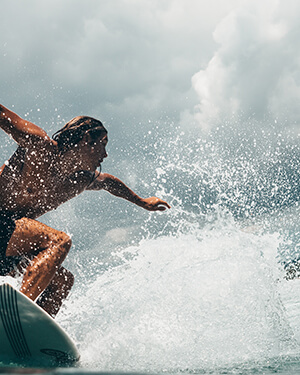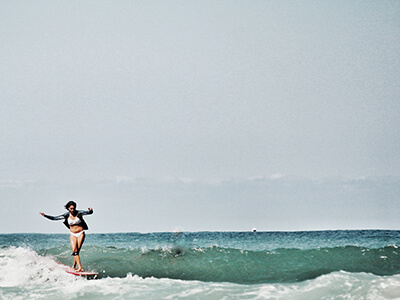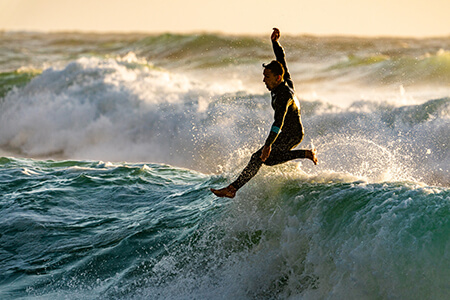My appreciation of the magical combination that is yoga and surfing dates back to one of my first ever yoga teaching jobs – working in a surf hostel in coastal Morocco.
It was the kind of job I look back on and smile at the fact I ever considered it work.
Each morning, I’d teach an energising flow class, setting the surfers up for their day on the waves, and each evening, I’d lead a restorative, grounding session to round off the day.
Days had a natural rhythm to them, and surfers proved to be easy going, yet committed and motivated yoga students.
Why Does the Combination of Yoga and Surfing Work So Well?
On a physical level, I reckon it comes down to a few commonalities:
- Both have advantages for physical strength which complement each other.
- Yoga builds upper body strength, which surfers need to paddle out to waves, while the core strength developed to steady you on the board is a real advantage on the yoga mat too.
- Balance is key.
- Surfing isn’t just about finding your feet on a surfboard, it’s also about staying there. Holding balance postures in yoga, whether that’s one-legged postures, arm balances or more challenging inversions is fantastic for building better stability and proprioception. (Learn more in 10 Benefits of Inversions.)
- Body awareness matters.
- Those who practice yoga are encouraged to fully inhabit their bodies and develop greater sensitivity towards their physical selves. What better way to do that than on a surf board, where you become acutely aware of every movement you make and the impact it has.
- One can provide great release and recovery from the other.
- It's simple to understand how yoga can release tension after surfing, easing out tight muscles and relieving any wave-induced aches and pains.
- However, the opposite can also be true. Especially for seasoned yogis, who will often repeat the same sequences of movements many times over, the diverse movements required when surfing can activate underused muscle groups, release holding patterns and bring greater balance to the physical body.
But as we know, there’s a lot more to yoga and, indeed, surfing than their physical benefits. Both also complement each other more holistically.
Why? Well…

Being Present
Yoga is a mindful practice, and yoga types talk a lot about the importance of bringing your full awareness into the present, moment by moment. (Learn more in 8 In-the-Moment Techniques to Cultivate Your Mindfulness Practice.)
That kind of focus and discipline is hard to learn.
Life is full of distractions, so even if you’re blessed with a calm and quiet space in which to practise yoga, it’s easy to get caught up in your mental busy-ness, remembering something that irritated you earlier that day, or planning what you’ll make for dinner later.
Yoga practice can too easily become "thinking time."
However, when catching a wave, it’s rarely necessary to tell yourself to focus. The mind is profoundly sharpened by the instability of your situation and the continual need to adjust your balance in order to not take a tumble.
Reconnecting With Nature
Surfing, far more than yoga, necessitates a re-connection with nature.
You can’t surf without building an intimate relationship with the elements of nature – sea on your skin, wind against your face and sun in your eyes.
Through removing the barriers between yourself and nature, through taking away the ceilings, the floors and the walls that separate you from the world, you experience yourself once again as a part of nature.
Many surfers describe their experiences out on the waves as spiritual, feeling deeply connected to the sea. By reconnecting with nature, you come close to your own true essence, the recognition of which is the ultimate goal of yoga. (Learn more in Accompany the Divine Play of Nature and Connect With Nurturing Mother Earth.)

Being Humble
Both yoga and surfing are great places to be confronted with your ego and learn how to manage it. (Learn more in How to See the Ego for What it Is.)
In yoga, it can be easy to get caught up in the drive to achieve a certain posture or look a particular way in a pose – whether that’s finding a deeper backbend or holding a stable handstand.
When your back doesn’t want to move in the way you want it to, or you just can’t find the steadiness you’re seeking upside down, it can be frustrating.
What the unpredictability of waves can teach you though is that we are rarely in control of all the factors that influence our movements, both physically and mentally.
Often all we can do is ride it out and see what comes next.
In the words of mindfulness teacher Jon Kabat-Zinn:
“You can’t stop the waves but you can learn to surf.”

Embracing Impermanence
In a similar vein, the transience of waves can teach us a lot about not clinging to moments, objects or feelings.
No matter how great the wave that you catch, and how incredible the feeling of surfing it, you know that even the very best waves are over quickly. (Learn more in Yoga's Philosophy on Calming the Waves of the Mind (Vritti).)
And on the other side of that, waves that disappoint are also fleeting.
Everything rises and everything falls away.
Just like in yoga and meditation, the key is learning to flow effortlessly from one moment to the next without getting caught up in the drama of it all.
And finally…
If you need a little more encouragement to embrace the surfing as a complement to your yoga practice, consider the words of international yoga teacher Shiva Rea:
“I surf—even in the middle of winter—whenever there is a swell. When the surf is up, the primordial teacher calls and I drop everything not essential and answer her call.”
During These Times of Stress and Uncertainty Your Doshas May Be Unbalanced.
To help you bring attention to your doshas and to identify what your predominant dosha is, we created the following quiz.
Try not to stress over every question, but simply answer based off your intuition. After all, you know yourself better than anyone else.